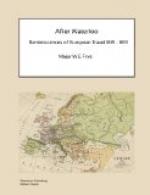[123] Because I am an Englishman—You are
an Englishman? you are certainly
a North-German; you speak
very correct German.—Gentlemen, I tell you
I am an Englishman; many English
study and speak the German language
and if you had held a long
conversation with me, you would soon have
perceived from my faults in
speaking, that I am not a German.—But you
have answered our questions
so correctly.—Why not, the same questions
have been put to me so often
that I have all the necessary answers by
heart like a catechism.
[124] Where is my father?
[125] “You wish to know where your father is?
He is under arrest; people
were well disposed to him;
but he is placed under arrest, because he
was unruly, and if you are
unruly you will be placed under arrest
likewise.”
CHAPTER XVII
SEPTEMBER 1818-MARCH 1819
The splendid city of Prague—The German expression, “To give the basket”—Journey from Prague to Dresden—Journey from Dresden to Berlin—A description of Berlin—The Prussian Army—Theatricals—Peasants talk about Napoleon—Prussians and French should be allies—Absurd policy of the English Tories—Journey from Berlin to Dresden—A description of Dresden—The battle of Dresden in 1813—Clubs at Dresden—Theatricals— German beds—Saxon scholars—The picture gallery—Tobacco an ally of Legitimacy—Saxon women—Meissen—Unjust policy of Europe towards the King of Saxony.
PRAGUE, 4 Sept.
Prague is a far more striking and splendid city than Vienna, without its faubourgs. The streets are broader; and it has a more cheerful and less confined appearance than the old town of Vienna. The position of Prague too is very romantic and picturesque, part of it lying on a mountain and part on a plain; and it stands on the confluent of two rivers, the Mulda and the Braun. The upper part of the city, called Oberburg, stands on a height called Ratschin, and on this height stands a most magnificent palace and other stately buildings. There is a beautiful panoramic view from this part of Prague. In this part of the city too is the cathedral of St Wenzel or Wenceslaus, who was its founder. His tomb and that of St John Nepomucene, a favorite saint of the Bohemians, is in this church. The Cathedral is of extreme solidity, but little ornamented, having been plundered by the Swedes in 1648. The canopy over the shrine of St John Nepomucene has a profusion of votive offerings appended to it. The lower part of Prague is divided into two parts by the Mulda. The bridge across the Mulda is one of the finest in Europe. It has twenty-four arches, its length is 1700 feet and its breadth 35. Among several statues on this bridge is a very remarkable one of Jesus Christ, made of bronze gilt, which cost a large sum of money to its founder, a Jew! There is a Latin inscription on it which explains the paradox.




